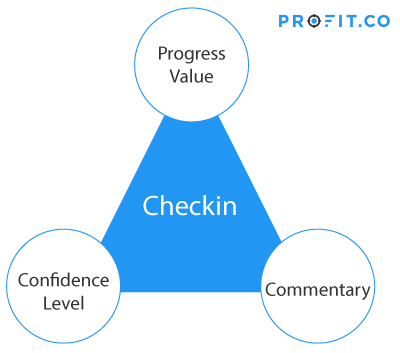Check-ins are an integral part of the OKR process. Profit.co has distinctly designed the OKR software with an automated check-ins option that would help you glide through the OKR process smoothly and easily. Most often check-ins are simply considered as a process to update the key result’s progress value. But it is more than that, through regular check-ins you get to know the consistent harmonious review of OKRs that helps the team to stay on track. The organization can positively feel ensured that the team members are spending enough time in managing the task. So knowing when and how the check-ins have to be automated is an intrinsic part to learn while dealing with OKRs & KPIs.
Check-ins comprises of three parts:

- Progress Value – Numerical indication of how the key result has been progressing
- Confidence Level – How confident is the key result owner, of achieving the target
- Commentary – A quick description of progress, challenges and outlook
If you’d like, you can automate #1, by updating the progress value from the various transactional or intelligence systems that house the underlying transactions. You really cannot automate #2 and #3, which are of equal importance, if not more.
What are KPI Integrations?
KPI integrations refer to updating the KPI progress value associated with key results automatically through connections with transaction systems. We are essentially referring to updates to KPI values from source systems like Salesforce.com, Zendesk, Zoho, JIRA, Oracle ERP, and SAP.
So, instead of having key result owners scrambling and searching across multiple systems to get the values of the KPIs they are tracking, just before their check-in meetings, how can we get those values automatically harvested and presented to them. And obviously there is a productivity angle, and an accuracy angle as well. We can certainly save the time that employees have to spend to get the right values. And then this tends to be more accurate since, you do get the real number from the source system. There’s no room for data entry errors.
Two schools of thought
There are two schools of thought, when it comes to automating KPI updates, representing two extremes, and then most companies can probably fall somewhere in between the two.
On one end, the thought is that OKR is a methodology and at the same time represents a mindset. It is important that your key results stay “top of the mind” for you. And there is a strict process element to it where you’re supposed to look at the progress, comment on it, reflect on it and articulate your future approach. This means that you have to have a clear demarcation between the transaction systems and the system that you use to track OKRs, be it spreadsheets or any software.
![]()
The other school of thought is, integrate heavily. The mantra is “I would like to set up my objectives and key results, but then update the key results from different sources of transaction systems that I normally use to execute my business.”
Well, as always, the answer to this question is the universal management answer, which is, “it depends.” As we have discussed in the past, your OKR position, which is a unique position, is plotted on those three axes we talked about: structure, process, and culture. So what is the best position for you, should we integrate completely, or should we not integrate at all is, obviously, something that you have to kind of iterate and figure out. And then again, there is a clear starting point, but there’s no clear destination. It’s a journey towards a better tomorrow through faster iterations.
Organizational Philosophy
OKRs need to be at the top of your mind, then one of the ways in which you can ensure that is by encouraging your employees to update their KPI progress themselves. There is a small amount of additional effort, but the organization feels that it’s worth it. Many large businesses practicing OKRs including Google, do not integrate transaction systems with their OKR Tracking.
We’ve heard many clients say “for an individual who’s working or who has a few OKRs, the values are supposed to be in their heads all the time.” And hence they ask “why do you even have to go and look out for the value?” Most of the time, as long as it’s a relatively stable KPI, you’ll have the value in your head. If not, you may have to look into your transaction system to get the latest number. But the idea is if you have that kind of a philosophical boundary, then it’s no problem, you just don’t have to do any integrations.
If you think that it’s a waste of time to update KPI values manually, you are not wrong. It’s not a bad idea to put some integrations in place so that data flows into your spreadsheets or to your OKR tracking application. You get the benefit of productivity, time savings, and accuracy.
Check-in Meeting Preparedness
If you decide to automate, you should ensure that people commit to providing good commentary. You don’t want people coming to meetings unprepared, which tends to happen with automation. Many times, especially in the initial days when employees are still figuring the OKR process out, they may say “Oh, okay. My number is 20 million. Let me think about what to do next week or month after the review.” That’s a red flag. Instead of that employees have to be forced write their own commentary that covers:
- What worked
- What didn’t
- What do they feel about the rest of the quarter
- How are they planning to achieve the remaining portion of the key result
- Any other relevant and useful areas of reflection
This commentary results in some level of reflection and also conversations with other people who are going to help the person to review and comment and plan for the next few weeks of the quarter. That’s all valuable.
The conversation that gets sparked by this initial commentary is really key. It’s a chain reaction. Think about what bad commentaries can do, which can happen with automatic updates. And if the commentary quality is low, then it doesn’t spark a lot of conversation. And then the great ideas that could have flown in, may not really flow in.
So it’s kind of like a chain reaction. you just have to work through it and identify the right mix of automation to ensure that your OKRs are supported by good, focused commentary and conversations.
So, when do you automate check-ins?
So, the question is whether you should be integrating and automatically updating KPI values for your key results? In our minds, the clear answer is not necessarily at the start of your OKR journey. Many times we see an undue amount of emphasis placed on automatic updates. Automating KPI updates does not guarantee your OKR program’s success. On the other hand, if you don’t see real progress through the conversations that happen in your check-in reviews, your OKR program will definitely fail to impress.
You should selectively integrate and update KPI values automatically. You can certainly start integrating a quarter or two into your OKR journey. When integrating, be aware of the fact that the confidence level and commentary that goes with the check-in are equally important and ensure that automatic updates don’t introduce a lull in your employees’ minds that as long as the check-in value is good, they can get away with mediocre or low-quality commentary. Also, use the best in class OKR management tool to see the triumph over your goals.
